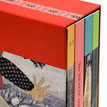| Bill Berkson |
History and Truth |
History of Art Department 2002 Commencement Address
University
of California, Berkeley, May 24, 2002
The title of this talk is “History
and Truth,” which may sound
beyond preposterous
for a brief commencement chat, but what I mean to do to is lay
out somewhat breezily some of my own diversity of purpose in the face of
such enormous abstractions—and hopefully those will seem less daunting,
more congenial by the time I’ve finished.
“Diversity”—because
it can only be an allowance of diversity that got
me here to address you today. I failed to ask Anne Wagner, when she called,
if I was being invited to talk as a poet, a critic or an art-historian-withoutportfolio
(which is what I am, at best and gladly, in that department). So I
don’t know what she or Tim Clark or anyone may have had in mind by
asking
me. It can’t be that I am standing here as just, so to speak, my
bare self,
flagrantly denuded of any degree of official representation. In truth,
I
know myself to be representative of no official order. I also know I agreed
to do this because when Anne said the date “May 24th” I immediately
thought of the first book of poems by a favorite poet, James Schuyler’s
May
24th or So, and a line in that book that goes:
You can’t
get at a sunset naming colors.
So, a pause
here for naming oneself, for convenient identity control—
just to get me out of the way: primarily, I am a writer—a
poet who, as the
art magazines say in their notes on contributors, “also writes about
art.”
Early in my poet’s life, 1960 or so, I slipped on a banana peel and
began
writing art criticism. The impetus was roughly that I wanted to avoid the
fate then typical for American poets, which was to teach literature and/or
creative writing in some small college far from where one wanted to be,
which in my case was my hometown of New York. The working model for
poets writing about contemporary art was conspicuous among New York
poets like John Ashbery, Frank O’Hara, Barbara Guest and Jimmy
Schuyler. (Could you tell that Schuyler was an art critic from his line
about
a sunset?) There was an honorable local tradition, and it seemed to fit;
so,
like several of my peer group in the second-generation New York School,
I
followed suit—until almost ten years later, with big changes in the
art
world (and particularly in the practice of criticism), the impetus wore
thin.
Moving to California in 1970, I abruptly left off, an art-world dropout.
Then again, another fifteen years down the line, primarily on the strength
of my New York background, I found myself hired to teach art history at
the San Francisco Art Institute. As bananas go, this was stray peel number
two—and as I was in dire need of steady employment at the time,
I appreciated
the chance to slip on it.
That takes
care of my history to the extent that most of what I just told you is
true. Is history an account of verifiable fact? The rest of this
talk—in the form of ruminations (literally, grazing the topic)—follows
from a set of epigraphs—two from Gertrude Stein, one from Robert
Smithson.
The last line
of Stein’s “If I Told Him: A Completed Portrait
of
Picasso,” completed in 1923, reads:
“Let
me recite what history teaches. History teaches.”
Joining this in my
mind is the last line of Stein’s 1929 opera libretto
Four Saints in Three Acts, chanted emphatically by the full chorus
in Virgil Thomson’s setting. That line goes:
“Which
is a fact.”
(Which I’ve
always felt to be the great, perfect exit line for just about
anything.)
Lastly, Robert
Smithson’s admonition, written many years later, in
the
late 1960s:
“All
clear ideas tend to be wrong.”
—
BILL BERKSON’s latest publications include an online chapbook, Same
Here, from
www.bigbridge.org (#11);
a collaboration with Bernadette Mayer entitled What’s
Your Idea of a Good Time?: Letter & Interviews 1977-1985 (Tuumba Press,
2006),
and a special issue of Fell Swoop magazine, Parts of the Body: A 1970s/80s
Scrapbook. He is the Distinguished Mellon Lecturer at the Skowhegan School
of Art for
2006.
For the complete article purchase The Sienese Shredder
#1
Back to The Sienese Shredder #1
| 

